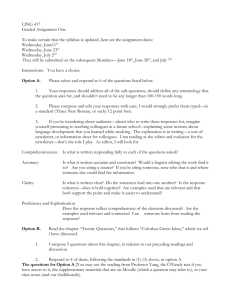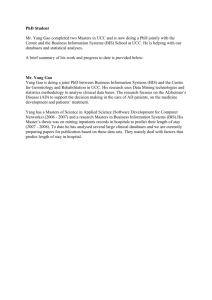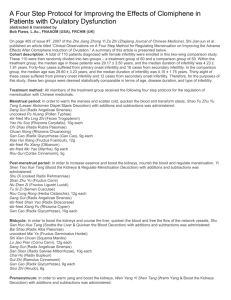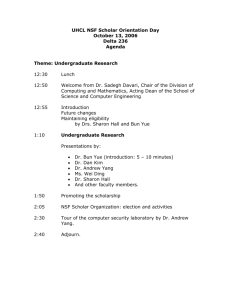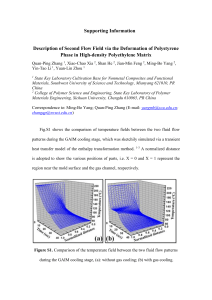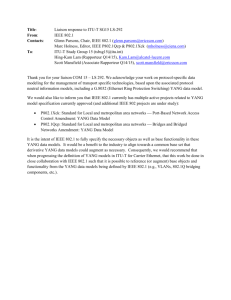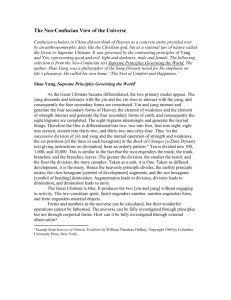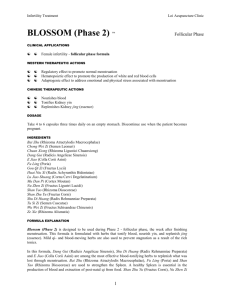Phase 3 - LoiAcupuncture.com
advertisement
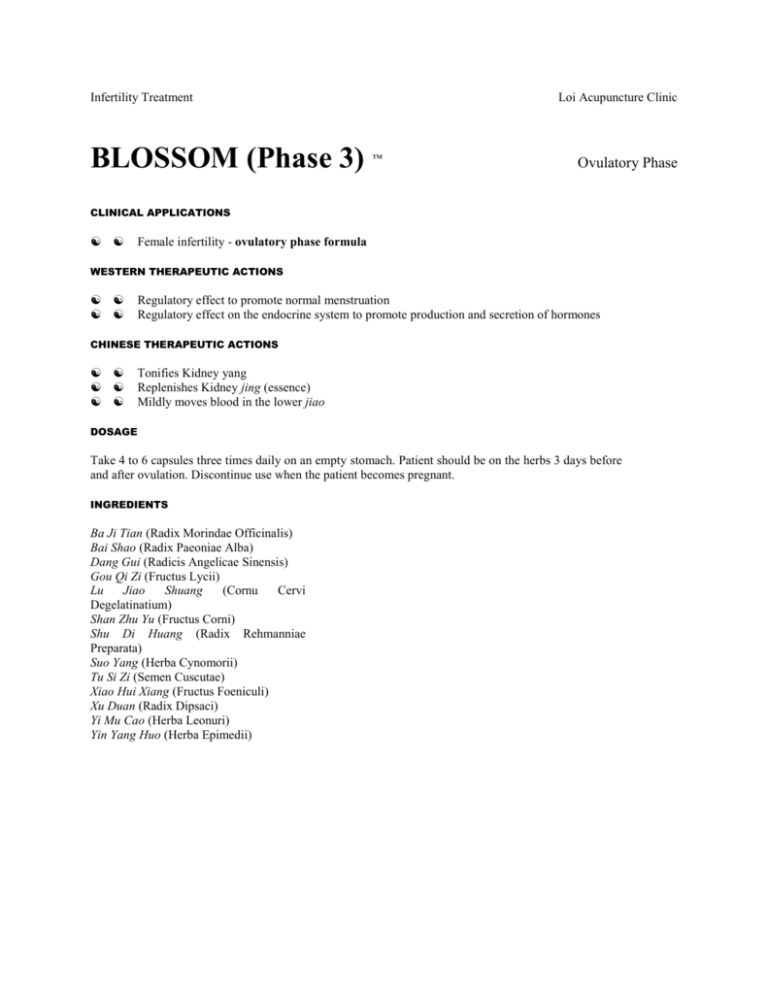
Infertility Treatment BLOSSOM (Phase 3) Loi Acupuncture Clinic ™ Ovulatory Phase CLINICAL APPLICATIONS Female infertility - ovulatory phase formula WESTERN THERAPEUTIC ACTIONS Regulatory effect to promote normal menstruation Regulatory effect on the endocrine system to promote production and secretion of hormones CHINESE THERAPEUTIC ACTIONS Tonifies Kidney yang Replenishes Kidney jing (essence) Mildly moves blood in the lower jiao DOSAGE Take 4 to 6 capsules three times daily on an empty stomach. Patient should be on the herbs 3 days before and after ovulation. Discontinue use when the patient becomes pregnant. INGREDIENTS Ba Ji Tian (Radix Morindae Officinalis) Bai Shao (Radix Paeoniae Alba) Dang Gui (Radicis Angelicae Sinensis) Gou Qi Zi (Fructus Lycii) Lu Jiao Shuang (Cornu Cervi Degelatinatium) Shan Zhu Yu (Fructus Corni) Shu Di Huang (Radix Rehmanniae Preparata) Suo Yang (Herba Cynomorii) Tu Si Zi (Semen Cuscutae) Xiao Hui Xiang (Fructus Foeniculi) Xu Duan (Radix Dipsaci) Yi Mu Cao (Herba Leonuri) Yin Yang Huo (Herba Epimedii) Infertility Treatment Loi Acupuncture Clinic FORMULA EXPLANATION Blossom (Phase 3) is developed specifically for Phase 3 - ovulatory phase, during the week of ovulation. The ovulatory stage is when Kidney yin is turning into yang and ovulation occurs with a peak in temperature. The primary treatment strategy is to help the eggs mature and promote ovulation. Kidney yang tonic herbs have the effect to enhance the surge of luteinizing hormone (LH), which then stimulates ovulation. To facilitate ovulation, mild blood-moving herbs are also added. Suo Yang (Herba Cynomorii) is traditionally used for infertility, low libido, lack of Kidney jing (essence) and other Kidney yang deficiency conditions. It is used here with Yin Yang Huo (Herba Epimedii), Lu Jiao Shuang (Cornu Cervi Degelatinatium), Xu Duan (Radix Dipsaci) and Ba Ji Tian (Radix Morindae Officinalis) to boost the yang and promote ovulation. Tu Si Zi (Semen Cuscutae) tonifies both Kidney yin and yang and is an essential herb for treating infertility. Xiao Hui Xiang (Fructus Foeniculi) warms the Kidney and the womb in preparation for pregnancy. Shu Di Huang (Radix Rehmanniae Preparata), Gou Qi Zi (Fructus Lycii), Bai Shao (Radix Paeoniae Alba) and Shan Zhu Yu (Fructus Corni) support Kidney yin for two purposes: First, to enhance the effects of the yang tonics, as both Kidney yin and yang should always be tonified together for maximum effect; second, to prevent the yang tonics from creating deficiency Kidney fire. Yang tonics as described above promote the release of the egg. Dang Gui (Radicis Angelicae Sinensis) tonifies blood and Yi Mu Cao (Herba Leonuri) moves the blood, which increases blood supply to the ovaries to induce the contraction of the muscles pulling the ovaries closer to the fallopian tubes, thus facilitating the movement of the egg into the fallopian tube. NUTRITION During the ovulatory phase, patients are advised to eat more lamb, which increases warmth of the body. CAUTIONS This formula should be discontinued when the patient becomes pregnant. Dang Gui (Radicis Angelicae Sinensis) may enhance the overall effectiveness of Coumadin (Warfarin), an anticoagulant drug. Patients who take anticoagulant or antiplatelet medications should not take this herbal formula without supervision by a licensed health care practitioner. ACUPUNCTURE POINTS Traditional Points: Guanyuan (CV 4), Qihai (CV 6), Sanyinjiao (SP 6), Zusanli (ST 36), Shenshu (BL 23), Taixi (KI 3), Taichong (LR 3), and Neiguan (PC 6). Balance Method by Dr. Richard Tan: Left side: Hegu (LI 4), Lingku, Yinlingquan (SP 9), Lougu (SP 7), and Sanyinjiao (SP 6). Right side: Neiguan (PC 6), Lieque (LU 7), Tongli (HT 5), Zusanli (ST 36), and Fenglong (ST 40). Alternate sides from treatment to treatment. Note: Lingku is one of Master Tong’s points. Lingku is located in the depression just distal to the junction of the first and second metacarpal bones, approximately 0.5 cun proximal to Hegu (LI 4), on the yangming line. For additional information on the Balance Method, please refer to Twelve and Twelve in Acupuncture and Twenty-Four More in Acupuncture by Dr. Richard Tan. MODERN RESEARCH Infertility Treatment Loi Acupuncture Clinic Blossom (Phase 3) is developed for Phase 3 - Ovulatory Phase, during the week of ovulation. To ensure proper maturation of eggs and subsequent ovulation, this formula uses herbs with a regulatory effect on the endocrine system to promote normal menstruation and the production and secretion of hormones. According to several studies, administration of Dang Gui (Radicis Angelicae Sinensis) is associated with both stimulating and inhibiting effects on the uterus, thereby exhibiting an overall regulatory effect on menstruation.i[1] Because of this regulatory effect, Dang Gui (Radicis Angelicae Sinensis) is beneficial and can be used before, during and after menstruation. To regulate ovulation, Blossom (Phase 3) uses many herbs with marked endocrinological effects, to promote the production and secretion of various hormones. For example, use of Shu Di Huang (Radix Rehmanniae Preparata) is associated with marked stimulating effect on the endocrine system, with the mechanism of action attributed to inhibiting negative feedback signals to the pituitary gland. ii[2] According to another study, administration of Ba Ji Tian (Radix Morindae Officinalis) also has a stimulant effect on the endocrine system and increases the production and release of hormones. iii[3] Most importantly, use of Yin Yang Huo (Herba Epimedii) has a stimulant effect on the endocrine system by increasing the production and secretion of endogenous hormones such as corticosterone, cortisol, and testosterone.iv[4] Lastly, this formula uses many herbs to facilitate and enhance the overall effect of therapy. Gou Qi Zi (Fructus Lycii) and Yi Mu Cao (Herba Leonuri) both have stimulating effects on the reproductive organs, namely the uterus, to prepare for conception. v[5],vi[6] In summary, this is an excellent formula specifically designed for women in Phase 3 – ovulatory phase of the menstrual cycle. It contains herbs that regulate menstruation, promote the production and secretion of hormones, and prepare the uterus for conception. i[1] Zhong Yao Xue (Chinese Herbology), 1998; 815:823 Zhong Yao Xue (Chinese Herbology), 1998; 156:158 Guo Wai Yi Xue Zhong Yi Zhong Yao Fen Ce (Monograph of Chinese Herbology from Foreign Medicine), 1990; 12(6):48 iv[4] Zhong Xi Yi Jie He Za Zhi (Journal of Integrated Chinese and Western Medicine), 1989; 9(12):737-8,710 v[5] Zhong Yao Xue (Chinese Herbology), 1998; 860:862 vi[6] Zhong Yao Yan Jiu (Research of Chinese Herbology), 1979; 581 ii[2] iii[3]

